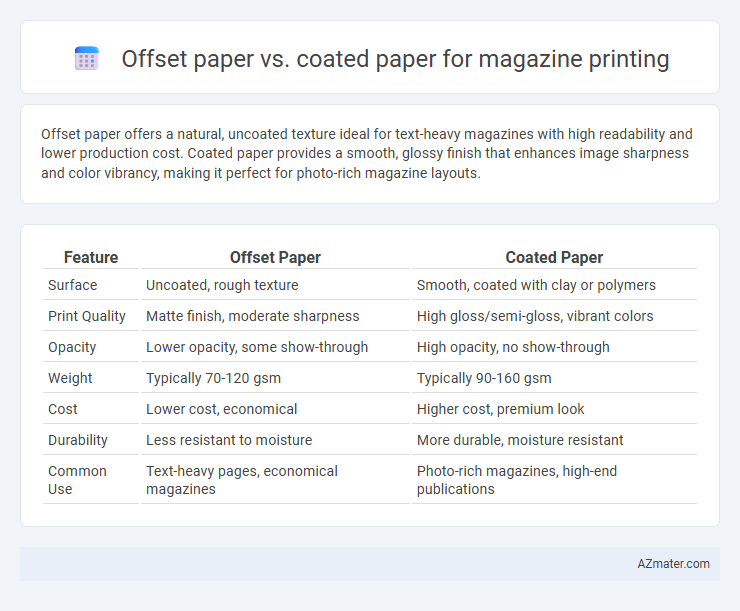Offset paper offers a natural, uncoated texture ideal for text-heavy magazines with high readability and lower production cost. Coated paper provides a smooth, glossy finish that enhances image sharpness and color vibrancy, making it perfect for photo-rich magazine layouts.
Table of Comparison
| Feature | Offset Paper | Coated Paper |
|---|---|---|
| Surface | Uncoated, rough texture | Smooth, coated with clay or polymers |
| Print Quality | Matte finish, moderate sharpness | High gloss/semi-gloss, vibrant colors |
| Opacity | Lower opacity, some show-through | High opacity, no show-through |
| Weight | Typically 70-120 gsm | Typically 90-160 gsm |
| Cost | Lower cost, economical | Higher cost, premium look |
| Durability | Less resistant to moisture | More durable, moisture resistant |
| Common Use | Text-heavy pages, economical magazines | Photo-rich magazines, high-end publications |
Introduction to Magazine Paper Types
Offset paper, known for its high brightness and smooth surface, is ideal for magazine printing due to its excellent ink absorption and cost-effectiveness. Coated paper, available in gloss, matte, and silk finishes, enhances image sharpness and color vibrancy, making it perfect for high-quality photo-rich magazines. Choosing between offset and coated paper depends on the desired print quality, durability, and budget considerations for the publication.
What is Offset Paper?
Offset paper is a specialized uncoated paper designed primarily for offset printing processes, featuring a smooth surface that enables sharp, detailed images ideal for text-heavy magazines. It offers excellent ink absorption and drying qualities, ensuring vibrant colors without smudging or bleeding. Its higher opacity compared to coated paper reduces show-through, enhancing readability in multi-page magazine layouts.
What is Coated Paper?
Coated paper features a smooth, glossy, or matte finish achieved by applying a surface coating of clay or other substances, enhancing ink holdout and image sharpness. Its improved opacity and brightness make it ideal for high-quality magazine printing where vibrant colors and crisp graphics are essential. Compared to offset paper, coated paper reduces ink absorption, resulting in sharper text and more vivid visuals.
Key Differences Between Offset and Coated Paper
Offset paper is specifically designed for offset printing, offering excellent ink absorption and producing sharp, clear images with a matte finish ideal for text-heavy magazines. Coated paper has a smooth, shiny surface treated with a coating material that enhances color vibrancy and sharpness, making it suitable for high-quality photo reproductions in magazines. The key differences lie in the coating presence, finish quality, ink absorption rate, and intended use, with offset paper prioritizing readability and coated paper emphasizing visual impact.
Print Quality Comparison
Offset paper offers a natural, uncoated surface that enhances text readability and delivers a softer, more muted print quality ideal for editorial content. In contrast, coated paper features a glossy or matte finish that produces sharper images and vibrant colors, making it the preferred choice for high-impact visuals in magazines. The choice between offset and coated paper significantly affects ink absorption and color saturation, directly influencing the overall print quality and reader experience.
Color Reproduction and Vibrancy
Offset paper offers excellent color reproduction with natural tones and smooth gradients, making it ideal for detailed text and subtle images in magazine printing. Coated paper enhances vibrancy by providing a glossy or matte finish that intensifies colors and sharpens image contrast, resulting in more striking and vivid magazine visuals. The choice between offset and coated paper significantly influences the magazine's overall color impact and visual appeal.
Cost Implications for Magazine Printing
Offset paper generally offers lower material costs compared to coated paper, making it a budget-friendly option for large-volume magazine printing. Coated paper, while more expensive, enhances print quality with its smooth and glossy finish, which may lead to higher production costs but improved visual appeal. Choosing between offset and coated paper requires balancing cost efficiency with the desired aesthetic impact and durability of the magazine.
Durability and Longevity
Offset paper offers superior durability and longevity for magazine printing due to its thicker fiber composition and resistance to yellowing over time. Coated paper, while providing a smooth, glossy finish that enhances color vibrancy, tends to be less durable as its coated surface can crack or peel with frequent handling. Magazines printed on offset paper maintain structural integrity and color stability longer, making it ideal for archival purposes and prolonged use.
Environmental Considerations
Offset paper for magazine printing typically features uncoated surfaces that use fewer chemical treatments, resulting in lower environmental impact due to reduced emissions and better recyclability. Coated paper involves additional chemical processes and coatings, which can hinder biodegradability and complicate recycling efforts, raising environmental concerns. Choosing offset paper supports more sustainable practices by minimizing chemical usage and promoting easier paper recovery in recycling facilities.
Choosing the Right Paper for Your Magazine
Offset paper offers a natural, uncoated finish that enhances readability and is ideal for magazines emphasizing text clarity and a matte appearance, while coated paper provides a glossy or satin surface that intensifies color vibrancy and sharpness, perfect for photo-heavy magazines. Selecting the right paper depends on the magazine's content type, desired aesthetic, and budget constraints; offset paper generally costs less and absorbs ink differently, producing softer images, whereas coated paper prevents ink absorption for crisper visuals. Understanding the balance between tactile feel, print quality, and production cost ensures the magazine's paper choice aligns with its brand identity and reader expectations.

Infographic: Offset paper vs Coated paper for Magazine printing
 azmater.com
azmater.com